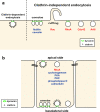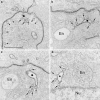Clathrin-independent endocytosis: from nonexisting to an extreme degree of complexity
- PMID: 18193449
- PMCID: PMC2248609
- DOI: 10.1007/s00418-007-0376-5
Clathrin-independent endocytosis: from nonexisting to an extreme degree of complexity
Abstract
Today it is generally accepted that there are several endocytic mechanisms, both the clathrin-dependent one and mechanisms which operate without clathrin and with different requirements when it comes to dynamin, small GTP-binding proteins of the Rho family and specific lipids. It should be noted that clathrin-independent endocytosis can occur even when the cholesterol level in the membrane has been reduced to so low levels that caveolae are gone and clathrin-coated membrane areas are flat. Although new investigators in the field take it for granted that there is a multitude of entry mechanisms, it has taken a long time for this to become accepted. However, more work needs to be done, because one can still ask the question: How many endocytic mechanisms does a cell have, what are their function, and how are they regulated? This article describes some of the history of endocytosis research and attempts to give an overview of the complexity of the mechanisms and their regulation.
Figures




References
-
- {'text': '', 'ref_index': 1, 'ids': [{'type': 'DOI', 'value': '10.1038/ncb1627', 'is_inner': False, 'url': 'https://doi.org/10.1038/ncb1627'}, {'type': 'PubMed', 'value': '17704769', 'is_inner': True, 'url': 'https://pubmed.ncbi.nlm.nih.gov/17704769/'}]}
- Balklava Z, Pant S, Fares H, Grant BD (2007) Genome-wide analysis identifies a general requirement for polarity proteins in endocytic traffic. Nat Cell Biol 9:1066–1073 - PubMed
-
- {'text': '', 'ref_index': 1, 'ids': [{'type': 'DOI', 'value': '10.1111/j.1600-0854.2007.00585.x', 'is_inner': False, 'url': 'https://doi.org/10.1111/j.1600-0854.2007.00585.x'}, {'type': 'PubMed', 'value': '17547704', 'is_inner': True, 'url': 'https://pubmed.ncbi.nlm.nih.gov/17547704/'}]}
- Benmerah A, Lamaze C (2007) Clathrin-coated pits: vive la difference? Traffic 8:970–982 - PubMed
-
- {'text': '', 'ref_index': 1, 'ids': [{'type': 'DOI', 'value': '10.1038/ncb1260', 'is_inner': False, 'url': 'https://doi.org/10.1038/ncb1260'}, {'type': 'PubMed', 'value': '15880102', 'is_inner': True, 'url': 'https://pubmed.ncbi.nlm.nih.gov/15880102/'}]}
- Bonazzi M, Spano S, Turacchio G, Cericola C, Valente C, Colanzi A, Kweon HS, Hsu VW, Polishchuck EV, Polishchuck RS, Sallese M, Pulvirenti T, Corda D, Luini A (2005) CtBP3/BARS drives membrane fission in dynamin-independent transport pathways. Nat Cell Biol 7:570–580 - PubMed
-
- {'text': '', 'ref_index': 1, 'ids': [{'type': 'DOI', 'value': '10.1083/jcb.200103107', 'is_inner': False, 'url': 'https://doi.org/10.1083/jcb.200103107'}, {'type': 'PMC', 'value': 'PMC2196179', 'is_inner': False, 'url': 'https://pmc.ncbi.nlm.nih.gov/articles/PMC2196179/'}, {'type': 'PubMed', 'value': '11535619', 'is_inner': True, 'url': 'https://pubmed.ncbi.nlm.nih.gov/11535619/'}]}
- Brown FD, Rozelle AL, Yin HL, Balla T, Donaldson JG (2001) Phosphatidylinositol 4,5-bisphosphate and Arf6-regulated membrane traffic. J Cell Biol 154:1007–1017 - PMC - PubMed
Publication types
MeSH terms
Substances
LinkOut - more resources
Full Text Sources

